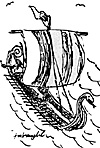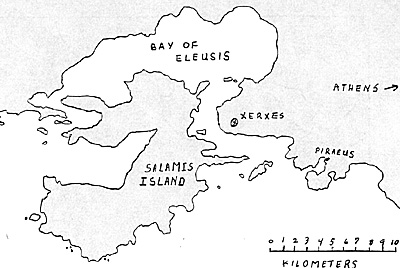 When Persia set out to invade Greece in 490 BC, the result was a dramatic conflict. Persia was the biggest power the ancient Middle East had ever seen. The forces of this huge empire were advancing against a small mountainous peninsula which was politically divided. Each city in Greece was a separate country. How could they possible resist an invasion?
When Persia set out to invade Greece in 490 BC, the result was a dramatic conflict. Persia was the biggest power the ancient Middle East had ever seen. The forces of this huge empire were advancing against a small mountainous peninsula which was politically divided. Each city in Greece was a separate country. How could they possible resist an invasion?
The Greeks saw themselves as free men resisting an oriental despot. King Darius' forces landing at Marathon were pushed back into the sea by the forces of Athens. Ten years later, Darius' son Xerxes collected a force larger than any before and began a new advance on Greece. Every part of the Persian Empire sent a contingent. This huge force was made up of an army and a navy. The army crossed into northern Greece and headed towards Athens. For once the Greeks were united to resist, but unity came a bit late. The Persian army wiped out 300 Spartans at Thermopylae and took Athens. The Persian navy had advanced along the coast. It too seemed unstoppable.
 The citizens of Athens had mostly fled their city. They were refugees on the island of salamis, a few miles from Athens. Their city was in enemy hands and in ruins. But Athens still had a powerful fleet, and the unified Greek fleet was at Salamis as well. Themistocles, the Athenian leader, had a daring plan. He sent a report to Xerxes telling him that the Greeks were at Salamis and if the Persians acted quickly, they could catch them. Xerxes moved his fleet to salamis and fell into a trap. The Greek fleet met the larger Persian fleet in the narrow waters of the Strait of salamis. In the confined space, Persian numbers were a handicap, not an asset, and the Greeks won a great victory. Xerxes left Greece, and a year later his army was driven out. The Battle of salamis had saved the Greeks. The Greeks, particularly the Athenians, went on to build the intellectual foundation of western civilization.
The citizens of Athens had mostly fled their city. They were refugees on the island of salamis, a few miles from Athens. Their city was in enemy hands and in ruins. But Athens still had a powerful fleet, and the unified Greek fleet was at Salamis as well. Themistocles, the Athenian leader, had a daring plan. He sent a report to Xerxes telling him that the Greeks were at Salamis and if the Persians acted quickly, they could catch them. Xerxes moved his fleet to salamis and fell into a trap. The Greek fleet met the larger Persian fleet in the narrow waters of the Strait of salamis. In the confined space, Persian numbers were a handicap, not an asset, and the Greeks won a great victory. Xerxes left Greece, and a year later his army was driven out. The Battle of salamis had saved the Greeks. The Greeks, particularly the Athenians, went on to build the intellectual foundation of western civilization.
The above summary does not do justice to the story as it has come down to us. The Greek historian Herodotus wrote his Histories a few years after the Persian War. Presumably he spoke with veterans, and his book came out at a time when many who had participated in the Persian Wars were still living. His version of events is one of the most immediate reports surviving. Aeschylus, the Athenian playwright, was in the Battle of Marathon and may have seen or participated in salamis. His play, The Persians, tells the story of the Persian War and the Battle of Salamis from a Persian viewpoint. The actual description of fighting at Salamis in The Persians is brief but graphic. Neither source is perfect. Herodotus was telling an exciting story of heroic free people (the Greeks) vs. an egomaniac and tyrannical ruler. His numbers are unreliable. Aeschylus is a dramatist.
Who can tell what dramatic license he took with the facts? Centuries later Plutarch wrote a life of Themistocles. His account adds some details not mentioned in either of the above. These may be from well-informed sources lost to us or later fanciful additions to the story. We'll never know.
Modern scholars have worked over the ancient sources and produced heavy tomes and confusion. Read enough and you will find disagreement about nearly everything. The date is disputed. Is it 479 B.C. or 480 B.C.? The size of the two fleets and their relative strengths varies with each expert. The map of the Strait of Salamis is open to question. The shoreline can change a lot in roughly 2500 years. Where exactly did the two fleets meet? How did the Persians maneuver when entering the strait?
I have tried to take all this scholarly confusion and use it to set up a solo system. I'll provide a map, some suggested rules, and options for playing the battle. A solo player can choose to play one side and dice for the other or program both sides using dice.
The Trireme
Modern experts have reconstructed a full-size working trireme. The trireme is a wooden ship powered by three banks of oarsmen. It has a slim hull with a ram in front. Currently it is part of NATO forces because it is the property of the Greek Navy. The research to build the trireme was funded by the Greek Navy because of the type's importance to their history. The modern reconstruction may or may not be accurate, but it does provide a set of performance figures based on actual tests. A crew of volunteer oarsmen (and a few? Women) put this ship through its paces.
The research behind the project was done at Cambridge University. Classicists combed Greek literature for mentions of triremes. Marine archeology produced some samples of ancient ship building methods by recovering ancient ships from sea bottoms. Excavations at Piraeus, the ancient Athenian port, revealed the dimension of the ship shelters and thus the dimension of the ships. Wen the Greek Navy volunteered to fund a full-scale reconstruction, the experts hired ship builders and taught them ancient methods. The result may not be an exact copy of the Athenian trireme, but it reflects a lot of research by a team of experts and the trial results look like the best available data on trireme performance.
Trireme: Statistics
- Length: 35 meters. Width: 3.5 meters
The width is for the hull not including the sweep of the oars. Oars would add roughly seven meters to the width.
Crew: 170 oarsmen and 14 marines. The oarsmen in ancient Athens were citizens serving in defense of their city.
Turn: 90 degrees turn in thirty seconds at six knots.
Speed: Over a 500 meter course in 2:30. (That's over twelve kilometers an hour or six and a half knots an hour.) Over a two kilometer course in 13:00. (That's nine kilometers an hour or four and seven-eighths knots an hour.) Maximum speed was just over seven knots under oar. For game purposes I rounded it up to 8 knots.
Acceleration: Standing to six knots in thirty seconds.
For game purposes, both sides are assumed to use triremes. The Persian side is tired, however. They spent the night on their ships.
More Salamis
Back to Table of Contents -- Lone Warrior #129
Back to Lone Warrior List of Issues
Back to MagWeb Magazine List
© Copyright 2000 by Solo Wargamers Association.
This article appears in MagWeb (Magazine Web) on the Internet World Wide Web.
Other military history articles and gaming articles are available at http://www.magweb.com
